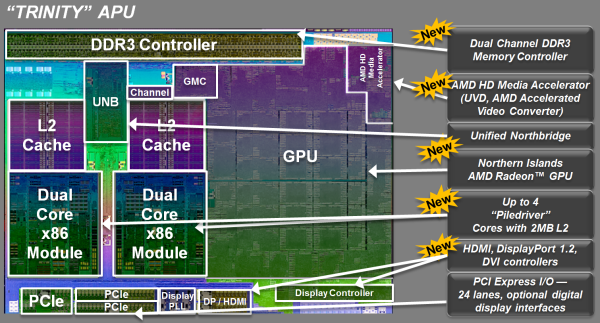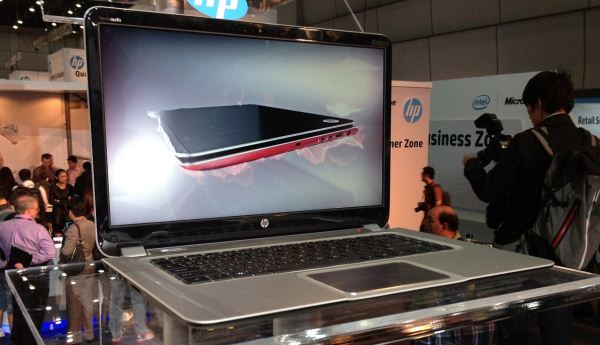The AMD Trinity Review (A10-4600M): A New Hope
by Jarred Walton on May 15, 2012 12:00 AM ESTConclusion: What Makes a Trinity?
I have often wondered about where AMD came up with the codename Trinity (other than the river name, of course). Was it a reference to this being AMD’s third APU? Or maybe AMD was gunning for the Holy Trinity of Performance, Battery Life, and Cost—get wins in all three areas and you’d have a guaranteed best seller! If that’s what AMD was hoping to accomplish, they’ve got a good foundation but we’ll need to see what the laptop OEMs come up with before issuing a final verdict.
To recap, Trinity is AMD’s continued journey down the path they started with Llano. Both CPU and GPU performance have improved over Llano. The general purpose CPU performance gap vs. Intel is somewhere in the 20—25% range, while the GPU advantage continues to be significantly in AMD's favor. It is surprising that Intel's HD 4000 is able to win even in some tests, but overall AMD continues to deliver better GPU performance even compared to Ivy Bridge. It's worth pointing out that the concerns about AMD's battery life from a few years ago are now clearly put to rest. At least at the TDPs we've tested, AMD is easily competitive with Intel on battery life.
AMD's GPU accelerated software lineup this time around is significantly better than it was with Llano, but we're still not quite where we need to be yet. I will hand it to AMD though, progress is clearly being made. Battery life is generally a step forward vs. Llano, which is more than we've been able to say about Ivy Bridge thus far.
The improvements in Piledriver really appear to have saved Trinity. What was a very difficult to recommend architecture in AMD's FX products has really been improved to the point where it's suitable for mobile work. AMD couldn't push performance as aggressively as it would have liked given that it's still on a 32nm process and the APU needs to make money. A move to 2x-nm could help tremendously. Similarly the move to a more efficient VLIW4 GPU architecture and additional tuning helped give AMD a boost in GPU performance without increasing die size. Overall, Trinity is a very well designed part given the process constraints AMD was faced with.
As a notebook platform, Trinity's CPU performance isn’t going to set any new records but it’s certainly fast enough for most users; battery life isn’t at the head of the class, but it’s better than just about anything that doesn’t qualify as an ultrabook; and finally there’s the question of cost. That last item isn’t really in AMD’s control, as the final cost of a laptop is a product of many design decisions, so let’s do some quick investigation into laptop pricing.
If you figure on memory, motherboard, chassis, LCD, and storage as all being the same, a typical laptop will have a starting price point of around $300—for a cheap, injection molded plastic shell, 4GB RAM, a 5400RPM HDD, a 1366x768 TN panel, and a no-frills feature set. Take that same basic platform and you can make an Intel laptop and have a BoM (Bill of Materials) cost of around $450, or you can make an AMD laptop and your BoM might start at $400. Depending on what other upgrades an OEM makes, as well as marketing, R&D, and profit, and we end up at a final price tag that might be $600 for a Trinity laptop compared to $700 for an Ivy Bridge laptop. The problem is that AMD doesn't just compete against vanilla Ivy Bridge; it has to compete against all the existing laptops as well.
Right now, Llano A8 laptops at Newegg have a starting price of $480 for an A8-3500M Acer Aspire, and they range up to $700 for a 17.3” HP dv7. The highest performance laptop of the bunch is probably Samsung’s Series 3, which uses an A8-3510MX APU and goes for $680. I suspect we’ll see similar pricing for Trinity laptops. On the Sandy Bridge Core i3/i5 side of the fence, Newegg has a much larger selection of laptops, starting at $430 for a Lenovo G570, $550 for the cheapest Core i5 model (again from Acer), and going up to $680 or more for laptops with Core i5 and NVIDIA Optimus graphics. Or if you prefer some place other than Newegg, you can find Core i5-2450M with GT 540M in Acer’s AS4830TG for $600.
That pretty much defines the maximum price we should expect people to pay for Trinity, as Core i5 with Optimus will deliver better CPU and GPU performance based on our test results. Obviously there are other factors to consider, like build quality of the laptop(s), display quality, battery life, and features, but most people shopping for an inexpensive laptop are going to be looking at cost first and features second. On the other hand, if you want style as a consideration, HP’s new sleekbooks will have Trinity versions starting at $600 for 15.6” and $700 for 14”—though it’s not clear which APU you’ll get at those prices. As long as last-generation Sandy Bridge laptops are at clearing house prices, though, AMD’s partners are going to need to be under $600 for something like the A10-4600M laptop we’re reviewing today. Assuming they can manage that, Trinity should see plenty of volume with the back to school season coming over the next few months.
For those who are interested in more than just the bottom line, as usual the best laptop for you may not be the best laptop for everyone. Trinity in a 14” form factor like our prototype would make for a great laptop to lug around campus for a few years. It would be fast enough for most tasks, small enough to not break your back, battery life would be long enough to last through a full day of classes, and the price would be low enough to not break your bank. And if mom and dad are footing the bill, you even get to disguise the fact that it’s a gaming capable laptop by not having a discrete GPU specifically called out on the features list. On the other hand, if you’re after a higher performance laptop or you want a “real” gaming system—something that can hand high detail settings at 1600x900 for instance—your best bet continues to be laptops with an Intel CPU and a discrete GPU from NVIDIA, at least of the GT 640M level—I’d say AMD GPUs as well, but I’m still waiting for a better switchable graphics solution.
At this point, AMD has done everything they can to provide a compelling mobile solution. The difficulty is that there's no longer a single laptop configuration that will be "best" for everyone, and Trinity only serves to further muddy the water. Intel continues to offer better CPU performance, and if you need graphics—which mostly means you want to play games—they have a good partner with NVIDIA. AMD on the other hand is delivering better integrated graphics performance with less CPU power, and depending on what you want to do that might be a more well rounded approach to mobile computing. What we need to see now are actual laptops and their prices. To trot out a tired old saying once more, "There are no bad products; only bad prices." Now it's up to AMD's partners to make sure Trinity laptops are priced appropriately.












271 Comments
View All Comments
AlB80 - Tuesday, May 15, 2012 - link
No.It's official information.
JarredWalton - Tuesday, May 15, 2012 - link
Except according to CLInfo, it does. Nice try?AlB80 - Tuesday, May 15, 2012 - link
Oops. It was.Now it has fp64 = 1/16 fp32.
princehamlet - Tuesday, May 15, 2012 - link
I was constantly refreshing the page at 12 AM! Couldn't wait for the reviews to be posted after the embargo was lifted :D.BSMonitor - Tuesday, May 15, 2012 - link
Why? Nothing earthshattering here. AMD is scalping resources from the CPU to add TDP room and die space for more of it's bulky Radeon shaders.It's like buying a laptop from 2004, with a DX11 upgrade.
AMD has the "good enough" part backwards. People want their laptop to be responsive when doing work, watching movies and browsing, etc. CPU intensive tasks. The good enough part, in regards to laptops would be the gaming. No one expects 60fps at 1080 out of laptop sitting on a plane flying somewhere.
Way to capture the hearts of the 1% of the 1% of people looking for great gaming from their $500 laptop.
Articuno - Tuesday, May 15, 2012 - link
Considering the CPU part is better than mobile Core 2 Duo parts (and thousands upon thousands of people are still using laptops with C2Ds) and the GPU part is several orders of magnitude better than Intel's best, I'd say buying an Intel laptop is like buying a laptop from 2004: expensive and extremely low price/performance for what you get.JarredWalton - Tuesday, May 15, 2012 - link
Whoa... several orders of magnitude? So, like, 1000X better? Because if anyone can offer up a GPU that's 1000 times faster than even GMA 4500, I'd take it! Turning down the hyperbole dial: AMD still has better drivers than Intel, but it's more like 20% better (just to grab a nice number out of thin air). Trinity's GPU is about 20% faster than HD 4000 as well, so that makes Trinity's GPU a whopping 44% better than "Intel's best".Now if you want to talk about the best Core 2 era IGP, then we'd be looking at more like an order of magnitude improvement. GMA 4500MHD scores around 1000 in 3DMark06, in case you were wondering (http://www.anandtech.com/show/2818/6). I know, it's only 3DMark -- still, call it 500 as a penalty for lousy drivers and HD 7660G is still "only" about 20X better.
/meaningless debate
Articuno - Tuesday, May 15, 2012 - link
Fair enough, kind of a knee-jerk reaction out of me there. Though I'm guessing the APU will be cheaper than the i7s it's going up against even without a discrete card added on top of them, so it's got very nice price/performance potential.jensend - Tuesday, May 15, 2012 - link
Yes, his "orders of magnitude" was hyperbole- but Intel's benchmark scores esp 3dmark really haven't reflected how awful their GPUs have been. The performance difference in real games was usually much bigger than that in synthetic benchmarks. You already mentioned driver issues. Even if you could get halfway decent performance out of some games, image quality was often a huge problem. If AMD or nV had offered that crappy of image quality they would have been totally excoriated in the press for cheating in order to inflate benchmarks; people didn't do that to Intel- probably because it would have felt like beating a handicapped child.But Sandy had some real improvements and then Ivy Bridge really turned things around for Intel. Beyond the performance improvements, after years of making excuses for their AF and saying that AA was unnecessary, they finally stopped making excuses and fixed them. Trinity is faster, but anybody who says that Ivy Bridge's graphics don't offer Trinity's any competition is badly mistaken.
Spunjji - Tuesday, May 15, 2012 - link
Indeed - I was honestly pleasantly surprised to see HD4000 sitting so high in the charts. Finally I won't need to start warning people against Intel notebooks!...except for the small problem of HD2500. Still, improvement is improvement.